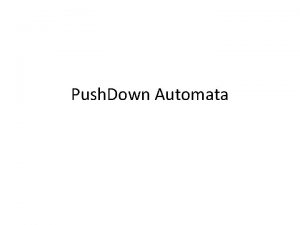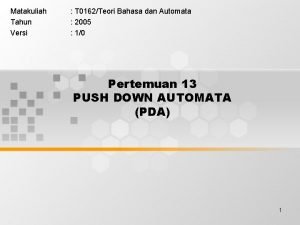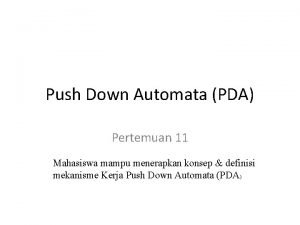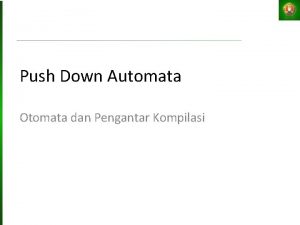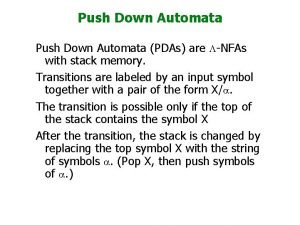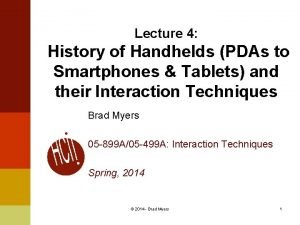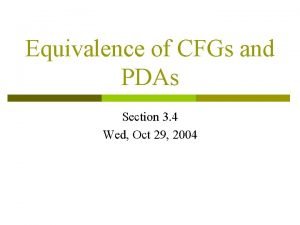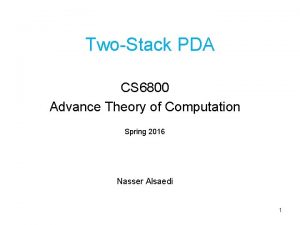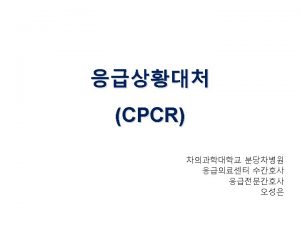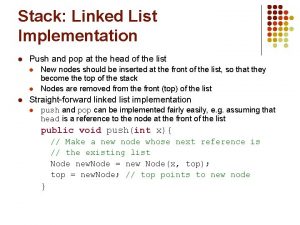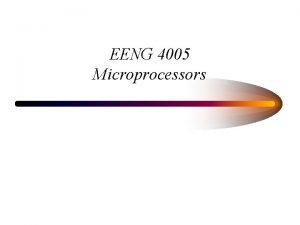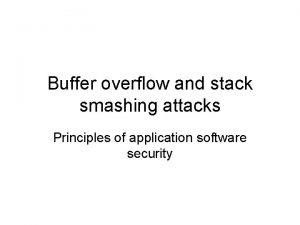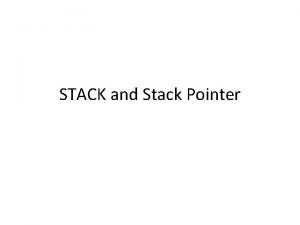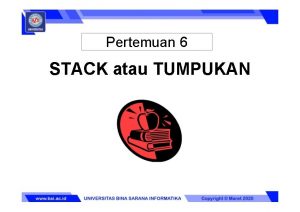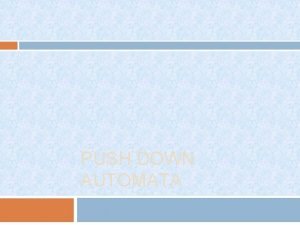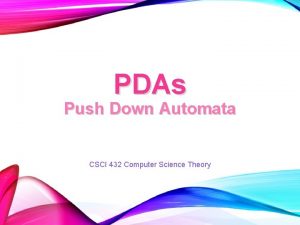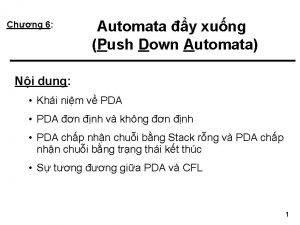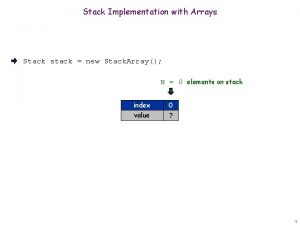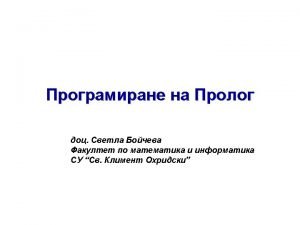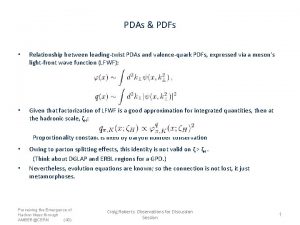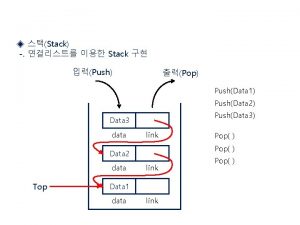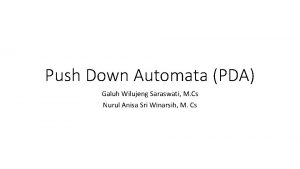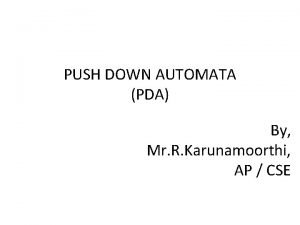Push Down Automata PDAs are LNFAs with stack




















- Slides: 20

Push Down Automata (PDAs) are L-NFAs with stack memory. Transitions are labeled by an input symbol together with a pair of the form X/a. The transition is possible only if the top of the stack contains the symbol X After the transition, the stack is changed by replacing the top symbol X with the string of symbols a. (Pop X, then push symbols of a. )

Example PDAs can accept languages that are not regular. The following one accepts: L={0 i 1 j | 0 £ i £ j} 0, X/XX s 1, Z 0/Z 0 1, X/e 0, Z 0/XZ 0 1, X/e p L, Z 0/Z 0 q

Definition A PDA is a 7 -tuple P=(Q, S, G, d, q 0, Z 0, F) where Q, S, q 0, F are as in NFAs, and • G is the stack alphabet. • Z 0 Î G is the start symbol; it is assumed that initially the stack contains only the symbol Z 0. • d: Q ×(SÈ{L}) × G ¾® P(Q × G*) is the transition function: given a state, an input symbol (or L), and a stack symbol, it gives us a finite number of pairs (q, a), where q is the next state and a is the string of stack symbols that will replace X on top of the stack.

In our example, the transition from s to s labeled (0, Z 0/XZ 0) corresponds to the fact (s, XZ 0)Î d(s, 0, Z 0). A complete description of the transition function in this example is given by d(s, 0, Z 0) = {(s, XZ 0)} d(s, 0, X) = {(s, XX)} 0, X/XX d(s, L, Z 0) = {(q, Z 0)} 0, Z /XZ 1, X/e d(s, 1, X) = {(p, e)} 1, X/e L, Z /Z s p d(p, 1, X) = {(p, e)} d(p, L, Z 0) = {(q, Z 0)} L, Z /Z d(q, 1, Z 0) = {(q, Z 0)} and d(q, a, Y)=Æ for all other possibilities. 0 0 0 1, Z 0/Z 0 q

Instantaneous Descriptions and Moves of PDAs IDs (also called configurations) describe the execution of a PDA at each instant. An ID is a triple (q, w, a), with this intended meaning: • q is the current state • w is the remaining part of the input • a is the current content of the stack, with top of the stack on the left.

The relation |- describes possible moves from one ID to another during execution of a PDA. If d(q, a, X) contains (p, a), then (q, aw, Xb) |- (p, w, ab) is true for every w and b. The relation |-* is the reflexive-transitive closure of |- We have (q, w, a) |-* (q', w', a') when (q, w, a) leads through a sequence (possibly empty) of moves to (q', w', a')

Automata and Formal Languages 0, X/XX s 1, Z 0/Z 0 1, X/e 0, Z 0/XZ 0 1, X/e p L, Z 0/Z 0 q Z 0/Z 0 (s, 011, z) |- (s, 11, xz) |- (P, 1, z)|-(q, 1, z) |- (q, ””, Z) (s, 011, z) |- (q, 011, Z) Lecture 13 Tim Sheard 7

Properties of |Property 1. If Then (q, x, a) |-* (p, y, b) (q, xw, ag) |-* (p, yw, bg) If you only need some prefix of the input (x) and stack (a) to make a series of transitions, you can make the same transitions for any longer input and stack. Property 2. If Then (q, xw, a) |-* (p, yw, b) (q, x, a) |-* (p, y, b) It is ok to remove unused input, since a PDA cannot add input back on once consumed.

The Language of a PDA A PDA as above accepts the string w iff (q 0, w, Z 0) |-* (p, L, a) is true for some final state p and some a. (We don't care what's on the stack at the end of input. ) The language L(P) of the PDA P is the set of all strings accepted by P.

Here is the chain of IDs showing that the string 001111 is accepted by our example PDA: (s, 001111, Z 0) |- (s, 01111, XZ 0) |- (s, 1111, XXZ 0) |- (p, 111, XZ 0) |- (p, 11, Z 0) |- (q, e, Z 0) 0, X/XX s 1, Z 0/Z 0 1, X/e 0, Z 0/XZ 0 1, X/e p L, Z 0/Z 0 q

The language of the following PDA is {0 i 1 j | 0 < i £ j}*. How can we prove this? 1, X, e 0, X/XX s 0, Z 0/XZ 0 p L, Z 0/Z 0 1, X/e q

Example A PDA for the language of balanced parentheses: (, Z 0/XZ 0 (, X/XX p ), X/e L, Z 0/Z 0 q

Acceptance by Empty Stack Define N(P) to be the set of all strings w such that (q 0, w, Z 0) |-* (q, L, e) for some state q. These are the strings P accepts by empty stack. Note that the set of final states plays no role in this definition. Theorem. A language is L(P 1) for some PDA P 1 if and only if it is N(P 2) for some PDA P 2.

Proof 1 1. From empty stack to final state. Given P 2 that accepts by empty stack, get P 1 by adding a new start state and a new final state as in the picture below. We also add a new stack symbol X 0 and make it the start symbol for P 1's stack. P 2 p 0 L, X 0/Z 0 X 0 q 0 L, X 0/e (add this transition from all states of P 2 to new state Pf) Pf

Proof 2 2. From final state to empty stack. Given P 1, we get P 2 again by adding a new start state, final state and start stack symbol. New transitions are seen in the picture. P 2 p 0 L, X 0/Z 0 X 0 q 0 L, G/ e P L, G/ e

Equivalence of CFGs and PDAs The equivalence is expressed by two theorems. Theorem 1. Every context-free language is accepted by some PDA. Theorem 2. For every PDA M, the language L(M) is context-free. We will describe the constructions, see some examples and proof ideas.

Given a CFG G=(V, T, P, S), we define a PDA M=({q}, T, T È V, d, q, S), with d given by – If A Î V, then d(q, e, A) = { (q, a) | A ® a is in P} – If a Î T, then d(q, a, a) = { (q, e) } 1. Note that the stack symbols of the new PDA contain all the terminal and non-terminals of the CFG 2. There is only 1 state in the new PDA, all the rest of the info is encoded in the stack. 3. Most transitions are on L, one for each production 4. The other transitions come one for each terminal. The automaton simulates leftmost derivations of G, accepting by empty stack. For every intermediate sentential form u. Aa in the leftmost derivation of w (note first that w = uv for some v), M will have Aa on its stack after reading u. At the end (case u = w) the stack will be empty.

Example For our old grammar: S ® SS | (S) | L the automaton M will have five transitions, all from q to q: 1. 2. 3. 4. 5. d(q, L, S) = (q, SS) S ® SS d(q, L, S) = (q, (S) ) S ® (S) d(q, L, S) = (q, L ) S ® L d(q, (, ( ) = (q, L) d(q, ), ) ) = (q, L) 1. Most transitions are on L, one for each production 2. The other transitions come one for each terminal.

Compare Now compare the leftmost derivation S Þ SS Þ (S)S Þ ((S))S Þ (())(S) Þ (())() with the M's execution on the same string given as input: (q, (q, (q, (q, "(())()" "())()" "))()" "()" ")" ")" e , S ) , SS ) , (S)S ) , (S))S ) , S ) , (S) ) , e ) ||||||- [1] [2] [4] [4] [3] [5] [2] [4] [3] [5] 1. 2. 3. 4. 5. d(q, L, S) = (q, SS) S ® SS d(q, L, S) = (q, (S) ) S ® (S) d(q, L, S) = (q, e ) S ® L d(q, (, ( ) = (q, L) d(q, ), ) ) = (q, L)

Next time We’ll prove the construction correct, Look at the inverse construction. PDA®CFL
 Insidan region jh
Insidan region jh Push down
Push down Push down automata (pda) didefinisikan dengan
Push down automata (pda) didefinisikan dengan Push down automata adalah
Push down automata adalah Contoh soal dan jawaban push down automata
Contoh soal dan jawaban push down automata Pda for balanced parentheses
Pda for balanced parentheses Rob haitani
Rob haitani Pdas and cfgs are equivalent
Pdas and cfgs are equivalent Pdas domains
Pdas domains Pda advance directive
Pda advance directive Resuscitation triangle roles
Resuscitation triangle roles Push hard push fast fully recoil
Push hard push fast fully recoil 5 back blows
5 back blows Capnoea
Capnoea Push hard push fast fully recoil
Push hard push fast fully recoil Push hard push fast fully recoil
Push hard push fast fully recoil Push(stack,l)
Push(stack,l) Push and pop in microprocessor
Push and pop in microprocessor Stack smashing
Stack smashing Stack and stack pointer
Stack and stack pointer Instruksi yang diberikan untuk menghapus data stack adalah
Instruksi yang diberikan untuk menghapus data stack adalah

